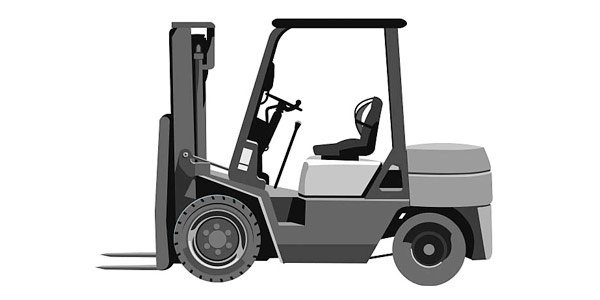2020 lift truck acquisition and usage study
Modern Materials Handling’s new lift truck usage study reveals key purchase patterns, challenges, and opportunities that fleet managers are facing in 2020.
Key players in the short-distance movement of goods under roof, out in the yard, on jobsites and for customer deliveries, lift trucks play a leading role in the modern supply chain. Ranging from basic models meant to handle small loads and guided by humans to large models that offer an array of advanced features, forms and functions, today’s lift trucks continue to evolve along with the technology that’s being put into them.
To better understand how Modern Materials Handling readers are acquiring, using, managing and maintaining their lift trucks in 2020, we recently conducted our annual tracking study. We asked our readers about the lift trucks that are in use and planned for acquisition; whether they’re buying, leasing or both; and the role that the current economic climate is playing in their lift truck procurement plans.
Our annual “2020 Lift Truck Acquisition and Usage Study” also explores lift truck maintenance arrangements, parts procurement and use of technology for managing lift truck fleets.
For this year’s Peerless Research Group (PRG) survey of Modern subscribers, the 158 readers who participated work in the manufacturing sector (41% of respondents), in DCs (32%) and in warehousing (19%). Overall, 72% work in the manufacturing industry, where their companies have an average of 410 employees and $774 million. Here’s what they shared with us.
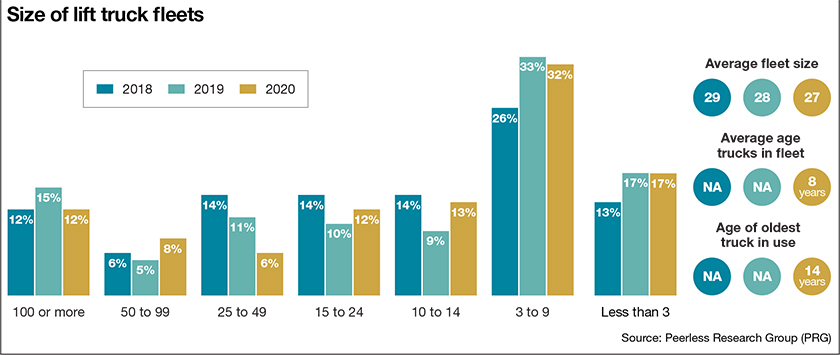
Ranked by popularity
Electric-powered rider trucks, pallet trucks and narrow-aisle trucks continue to reign in the warehouse environment, where usage numbers of all three of these major types dropped slightly in 2020 compared to last year. Electric-powered rider trucks, including counterbalanced, sit-down and stand-up types (Class I), are now the most popular, with a 62% usage rate (down from 64% in 2019).
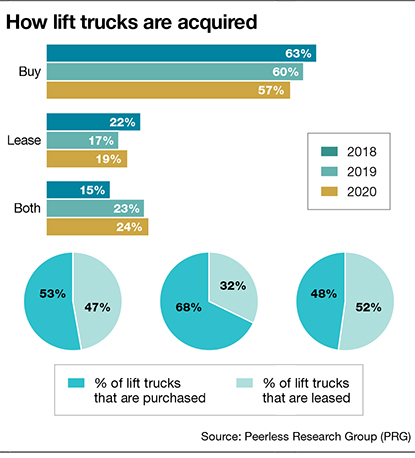 Electric-powered pallet trucks, including walkies, riders, low and high lift, and reach types (Class 3), saw a slight decrease from 49% in 2019 to 46% in 2020. Use of electric-powered narrow-aisle trucks, including orderpickers, side-loaders, turret trucks, stackers and reach trucks (Class 2), decreased from 52% in 2019 to 40% in 2020, indicating that these vehicles may be waning in popularity.
Electric-powered pallet trucks, including walkies, riders, low and high lift, and reach types (Class 3), saw a slight decrease from 49% in 2019 to 46% in 2020. Use of electric-powered narrow-aisle trucks, including orderpickers, side-loaders, turret trucks, stackers and reach trucks (Class 2), decreased from 52% in 2019 to 40% in 2020, indicating that these vehicles may be waning in popularity.
Other types of lift trucks in use in the warehouse and DC include IC-powered counterbalanced lift trucks with cushion tires (Class 4), with 29% adoption rates (versus 41% last year), and IC-powered counterbalanced lift trucks with pneumatic tires (Class 5), which are being used by 23% of companies (down from 26% last year).
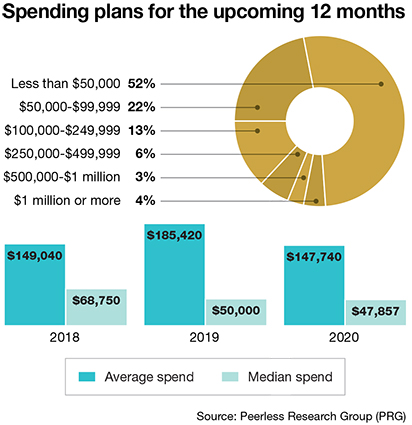 Use of rough terrain lift trucks (Class 7) decreased slightly this year, while electric-powered and IC-powered rider-type tow tractors (Class 6) are being used by 8% of companies—a 1% uptick over 2019. The latter was the only category to see an increase in usage rates in 2020 versus the prior year.
Use of rough terrain lift trucks (Class 7) decreased slightly this year, while electric-powered and IC-powered rider-type tow tractors (Class 6) are being used by 8% of companies—a 1% uptick over 2019. The latter was the only category to see an increase in usage rates in 2020 versus the prior year.
Smaller fleets on the rise
In 2020, the sweet spot for companies leasing or owning lift trucks fell somewhere between three and nine vehicles (32%). Similar to 2019, 17% of companies have less than three trucks in their fleets while 13% of companies have 10 to 14 trucks. The latter represents an increase of 9% compared to last year.
Many companies have a moderately sized fleet that falls somewhere in the middle, with 12% of companies using anywhere from 15 to 24 trucks.
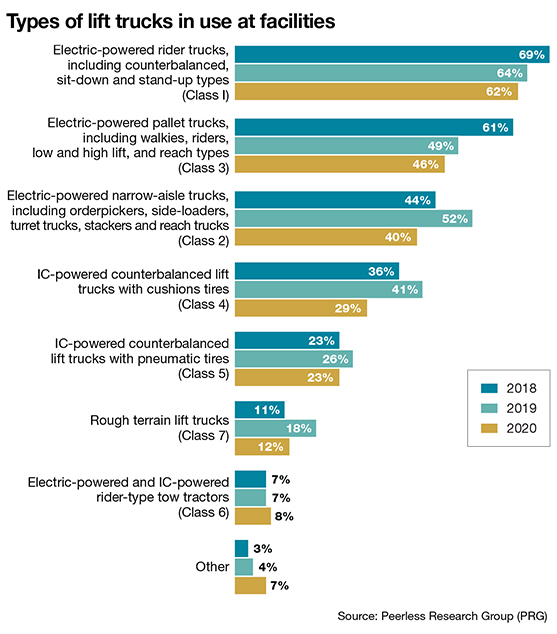 According to the survey, 12% of companies have fleet sizes of 100 or more trucks, which is down from 15% last year. Similarly, 8% say they have somewhere between 50 and 99 trucks in their fleet (versus 5% last year).
According to the survey, 12% of companies have fleet sizes of 100 or more trucks, which is down from 15% last year. Similarly, 8% say they have somewhere between 50 and 99 trucks in their fleet (versus 5% last year).
Six percent of companies have 25 to 49 vehicles in their fleets (down from 11% in 2019). The average fleet size among all respondents is 27 trucks, and the average age of the trucks in the fleet is eight (the oldest truck in use right now is 14 years old).
Lift truck buying and replacement trends
For 69% of Modern’s readers, the most important characteristic when evaluating lift trucks for purchase or lease is quality of the lift truck and parts. Sixty-seven percent of respondents believe safety is important, while 64% see purchase price as a key determining factor. And, 52% of buyers are also concerned about the cost to run the truck over its lifetime, and 50% are focused on service response time.
Asked about their truck replacement and retirement schedules, respondents say the average replacement time for lift trucks is every 7.7 years, which is consistent with 2019’s survey results. Thirty-three percent of respondents say their replacement timeline is 10 years or more, while 28% say they replace trucks every five to eight years. And, 17% say they retire trucks after less than five years.
When companies acquire new vehicles and dispose of older ones, more than half (53%) say the dealer takes the older truck when the new one is delivered. This option has grown in popularity since 2019, when 38% of respondents used this disposal method. Other popular options include reselling their lift trucks (for 41% of companies), storing them (31%), or using them for parts (18%).
Although companies have multiple sales channels to choose from when purchasing lift trucks, the majority, 79%, buy direct from their dealers (down from 89% in 2019). Twenty-five percent buy directly from the manufacturer (up from 20% last year), and 9% say they purchase through some other channel.
Fleet acquisition
When it comes time to add or replace a lift truck in their fleets, companies must decide whether to buy or lease. In 2020, 48% of lift trucks were purchased and 52% were leased. These results differ from 2019, when 68% were purchased and 32% were leased. However, some prefer to mix buying with leasing to create a hybrid approach. According to the survey, 24% of respondents use this combined approach. Fifty-seven percent say they typically buy (down from 60% last year) and 19% say they lease (versus 17% in 2019).
Over the next two years, 51% of respondents say they’re likely to buy or lease a lift truck—a number that fell from 62% in 2019. When asked how many lift trucks they plan to purchase or lease during that period, most (39%) will buy two to four trucks and 21% will purchase between five and nine vehicles. On average, companies plan to buy 7.6 trucks over the next 24 months, compared to 6.6 in 2019.
Measuring the economic impacts
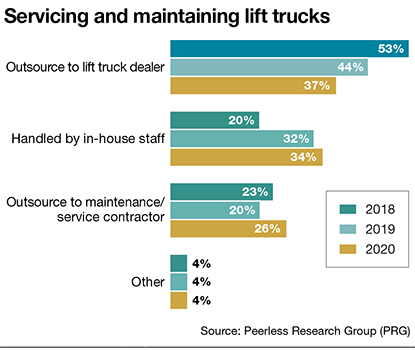 Recent events like the Covid-19 pandemic and recessionary conditions altered many equipment purchasing plans for 2020, and lift trucks were no exception. According to the Modern survey, 29% of respondents say the economy impacts their lift trucks to a great extent, up from 22% last year.
Recent events like the Covid-19 pandemic and recessionary conditions altered many equipment purchasing plans for 2020, and lift trucks were no exception. According to the Modern survey, 29% of respondents say the economy impacts their lift trucks to a great extent, up from 22% last year.
Thirty-eight percent of respondents say the economy does impact their purchasing to some extent, up from 31% last year. However, 33% say it has little or no impact, which is a large decrease from 47% last year.
“We are a warehouse and fulfillment company,” one respondent points out. “If we have no orders coming in, we have no employees fulfilling orders and no lift trucks are being used. Lastly, with no money coming in, the last thing we will think about is our lift trucks and upgrading.”
According to the survey, 52% of companies plan to spend less than $50,000 on lift trucks in the next year. Twenty-two percent plan to spend between $50,000 and $99,999. In total, 74% plan to spend less than $100,000 in the next 12 months.
On the higher end, 13% plan to spend between $100,000 and $249,999; 6% plan to spend $250,000 and $499,999; and 3% say they plan to spend $500,000 to $1 million. The average anticipated spend for lift trucks over the next year was $149,040, which is lower than last year’s average of $185,420, but consistent with 2018’s average of $147,740.
Parts and servicing
For lift truck operators, wheels and tires are the most common parts in need of replacement. In 2020, 57% say they are likely to purchase or replace wheels and tires, down from 62% in 2019.
Batteries and battery accessories have also seen a decline to 54%, versus 63% in 2019. The use of tune-up parts (52%), chemicals, lubricants and oil (49%), and seats (25%) have all stayed fairly consistent with 2019.
This year, 46% of respondents say they are likely to purchase or replace brake components (49% last year), and 35% plan to buy safety equipment (33% last year). Forks and chains were the least commonly used replacement parts, at 16% and 13% respectively. And, 22% are likely to buy starters and alternators (versus 29% in 2019).
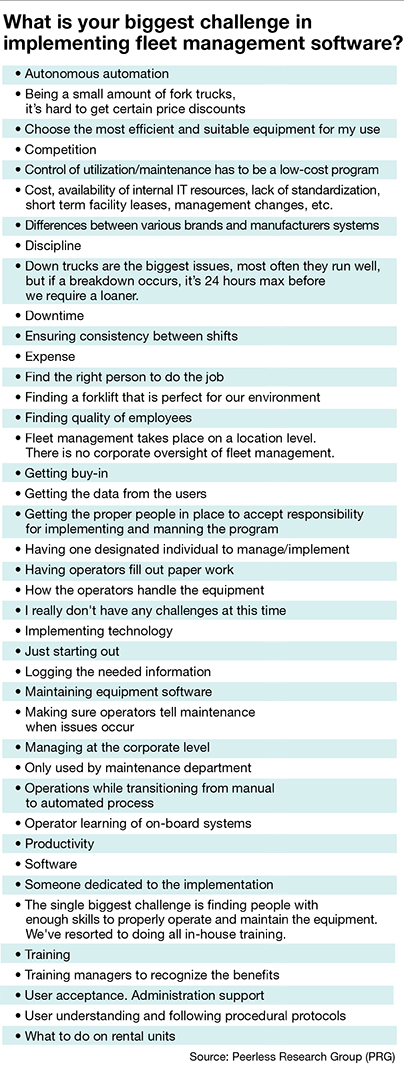 Asked how they service and maintain their lift truck fleets, 37% of companies outsource to their lift truck dealers, which is down from 44% in 2019 and 53% in 2018, indicating a downward trend in this approach. Gaining in popularity, in-house servicing and maintenance is now used by 34% of respondents (up from 32% in 2019 and 20% in 2018). Twenty-six percent say they outsource to a maintenance or service coordinator.
Asked how they service and maintain their lift truck fleets, 37% of companies outsource to their lift truck dealers, which is down from 44% in 2019 and 53% in 2018, indicating a downward trend in this approach. Gaining in popularity, in-house servicing and maintenance is now used by 34% of respondents (up from 32% in 2019 and 20% in 2018). Twenty-six percent say they outsource to a maintenance or service coordinator.
Fleet management technology
This year, 50% of respondents say they’ve adopted fleet management software, up from 39% last year. Seventy-two percent say they are tracking maintenance history, 70% are tracking safety (i.e., such as accidents and injuries), and 61% are tracking the cost to maintain their lift trucks.
For those companies that have yet to implement—or don’t have plans to implement—fleet management software, most blame budgetary constraints and small fleet sizes for their reluctance.
Asked to reveal their biggest challenges in implementing and/or using a fleet management software solution, respondents point to autonomous automation, competition, cost, discipline, downtime and training as the biggest obstacles.
Others can’t find the right equipment or the right people to deploy the technology. Getting buy-in from both management and customers is another large barrier, as is the transition from traditional/manual to automated processes.


